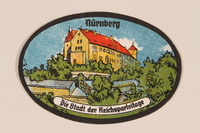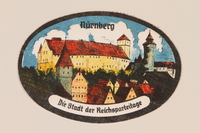Overview
- Brief Narrative
- Issue of Der Stürmer with the subtitle, Deutsches Wochenblatt zum Kampfe um die Wahrheit, [German weekly magazine in the struggle for truth.] It has the headline, Judenaufruhr [Jewish revolt] and a front page illustration by Fips of Jewish businessman captioned, Im Zeichen der Schlange [Under the Sign of the Serpent]. Der Stürmer was a viciously anti-Jewish newspaper published by Julius Streicher, an early Nazi Party member, from 1923-1945 in Germany. The newspaper's frequent subtitle was "Die Juden sind unser Unglück!" [The Jews are our misfortune]. The paper thrived on scandal and preferred sensational stories of Jews committing disgusting, evil acts. It was also infamous for its antisemitic cartoons by Fips (Philipp Rupprecht.) Streicher was arrested by the US Army in May 1945. He was tried by the International Military Tribunal at Nuremberg, convicted, and executed per the ruling that his repeated articles calling for the annihilation of the Jewish race were a direct incitement to murder and a crime against humanity.
- Title
- Der Stürmer, Nummer 26, Juni 1934, 12. Jahr 1934
- Alternate Title
- The Striker, Number 26, June 1934, 12th year 1934
- Date
-
publication/distribution:
1934 June
- Geography
-
publication:
Nuremberg (Germany)
- Credit Line
- United States Holocaust Memorial Museum Collection, Gift of Hans Pauli
- Contributor
-
Editor:
Julius Streicher
Publisher: Stürmer-Verlag
- Biography
-
Julius Streicher was the founder of "Der Stürmer" and Gauleiter of Franconia. He was sentenced to death at the International Military Tribunal in Nuremberg.
[Encyclopedia of the Holocaust. Vol. 3-4. New York: MacMillan Publishing Company, 1995, pp. 1788.]
Physical Details
- Language
- German
- Classification
-
Books and Published Materials
- Category
-
Newspapers
- Object Type
-
German newspapers (lcsh)
- Genre/Form
- Newspapers.
- Physical Description
- Issue of Der Sturmer newspaper ; 8 p. (2 sheets folded) ; 17 x 12.500 inches.
v. : ill. ; 43 cm.
Weekly
Nr. 1 (1923)-
Ceased in Feb. 1945.
Notes: Subtitle varies.
Editor: Julius Streicher.
It has colored pencil markings, tears, and discoloration. - Materials
- overall : paper, ink
Rights & Restrictions
- Conditions on Access
- No restrictions on access
Keywords & Subjects
- Topical Term
- Anti-Jewish propaganda--Germany--Sources. Antisemitism in the press--Germany. Jews--Persecutions--Germany--Periodicals. Jews--Press coverage--Germany--Periodicals. National socialism--Periodicals. Press and propaganda--Germany.
- Geographic Name
- Germany--Politics and government--1933-1945--Newspapers.
- Personal Name
- Fips, 1900-1975.
Administrative Notes
- Legal Status
- Permanent Collection
- Provenance
- The newspaper was donated to the United States Holocaust Memorial Museum in 1990 by Hans Pauli.
- Funding Note
- The cataloging of this artifact has been supported by a grant from the Conference on Jewish Material Claims Against Germany.
- Record last modified:
- 2024-03-28 10:55:47
- This page:
- https://collections.ushmm.org/search/catalog/irn2922
Also in Hans Pauli collection
The collection consists of a June 1934 issue of Der Stürmer and two undated cloth patches promoting Nuremberg as the site of Nazi Party rallies.
Date: 1934 June

Badge
Object
Colorful patch advertising Nuremberg as the site of Nazi Party Rallies acquired by Hans Pauli in Italy at an unknown date before 1990. In the 1920s and annually from 1933-1938, this German city in Bavaria was where the Nazi Party staged massive and lavish rallies. Here on September 15, 1935, Hitler announced the Nuremberg Laws, racial based antisemitic legislation for the systematic persecution of Jews in Germany. In 1943, the Allies decided to hold an International Military Tribunal to prosecute those responsible for war crimes and violence against civilian populations. In summer 1945, after the war's end in May, a review of possible sites for the Trial of Major War Criminals led to the selection of Nuremberg. Like much of Germany, most of the city was destroyed by bombing. The Palace of Justice was the only facility both undamaged and extensive enough to accommodate the trial.

Badge
Object
Colorful patch advertising Nuremberg as the site of Nazi Party Rallies acquired by Hans Pauli in Italy at an unknown date before 1990. In the 1920s and annually from 1933-1938, this German city in Bavaria was where the Nazi Party staged massive and lavish rallies. Here on September 15, 1935, Hitler announced the Nuremberg Laws, racial based antisemitic legislation for the systematic persecution of Jews in Germany. In 1943, the Allies decided to hold an International Military Tribunal to prosecute those responsible for war crimes and violence against civilian populations. In summer 1945, after the war's end in May, a review of possible sites for the Trial of Major War Criminals led to the selection of Nuremberg. Like much of Germany, most of the city was destroyed by bombing. The Palace of Justice was the only facility both undamaged and extensive enough to accommodate the trial.



